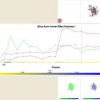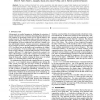VIS
2007
IEEE
16 years 2 months ago
2007
IEEE
121
Voted
VIS
2007
IEEE
16 years 2 months ago
2007
IEEE
Recent developments in biomedical imaging are producing massive data sets containing structures, such as fine filaments, that are difficult to visualize. In this paper, we describ...
119
Voted
VIS
2007
IEEE
16 years 2 months ago
2007
IEEE
The effectiveness of direct volume rendering is difficult to validate and users may not know whether they have successfully explored the data or not. This limits its applications....
113
Voted
VIS
2007
IEEE
2007
IEEE
Modeling Perceptual Dominance Among Visual Cues in Multilayered Icon-based Scientific Visualizations
16 years 2 months ago
ization method is an abstract function that transforms a scientific dataset into a visual representation to facilitate data exploration. In turn, a visualization display is the vis...
117
Voted
VIS
2007
IEEE
16 years 2 months ago
2007
IEEE
In nature and in flow experiments particles form patterns of swirling motion in certain locations. Existing approaches identify these structures by considering the behavior of stre...
126
click to vote
VIS
2007
IEEE
16 years 2 months ago
2007
IEEE
We present a novel approach for analyzing two-dimensional (2D) flow field data based on the idea of invariant moments. Moment invariants have traditionally been used in computer vi...
99
Voted
VIS
2007
IEEE
16 years 2 months ago
2007
IEEE
Abstract--We present a method to extract and visualize vortices that originate from bounding walls of three-dimensional timedependent flows. These vortices can be detected using th...
117
click to vote
VIS
2007
IEEE
16 years 2 months ago
2007
IEEE
Abstract-- We describe a system for interactively rendering isosurfaces of tetrahedral finite-element scalar fields using coherent ray tracing techniques on the CPU. By employing s...
111
Voted
VIS
2007
IEEE
16 years 2 months ago
2007
IEEE
We have combined methods from volume visualization and data analysis to support better diagnosis and treatment of human retinal diseases. Many diseases can be identified by abnorma...
116
Voted
VIS
2007
IEEE
16 years 2 months ago
2007
IEEE
We describe our visualization process for a particle-based simulation of the formation of the first stars and their impact on cosmic history. The dataset consists of several hundre...


